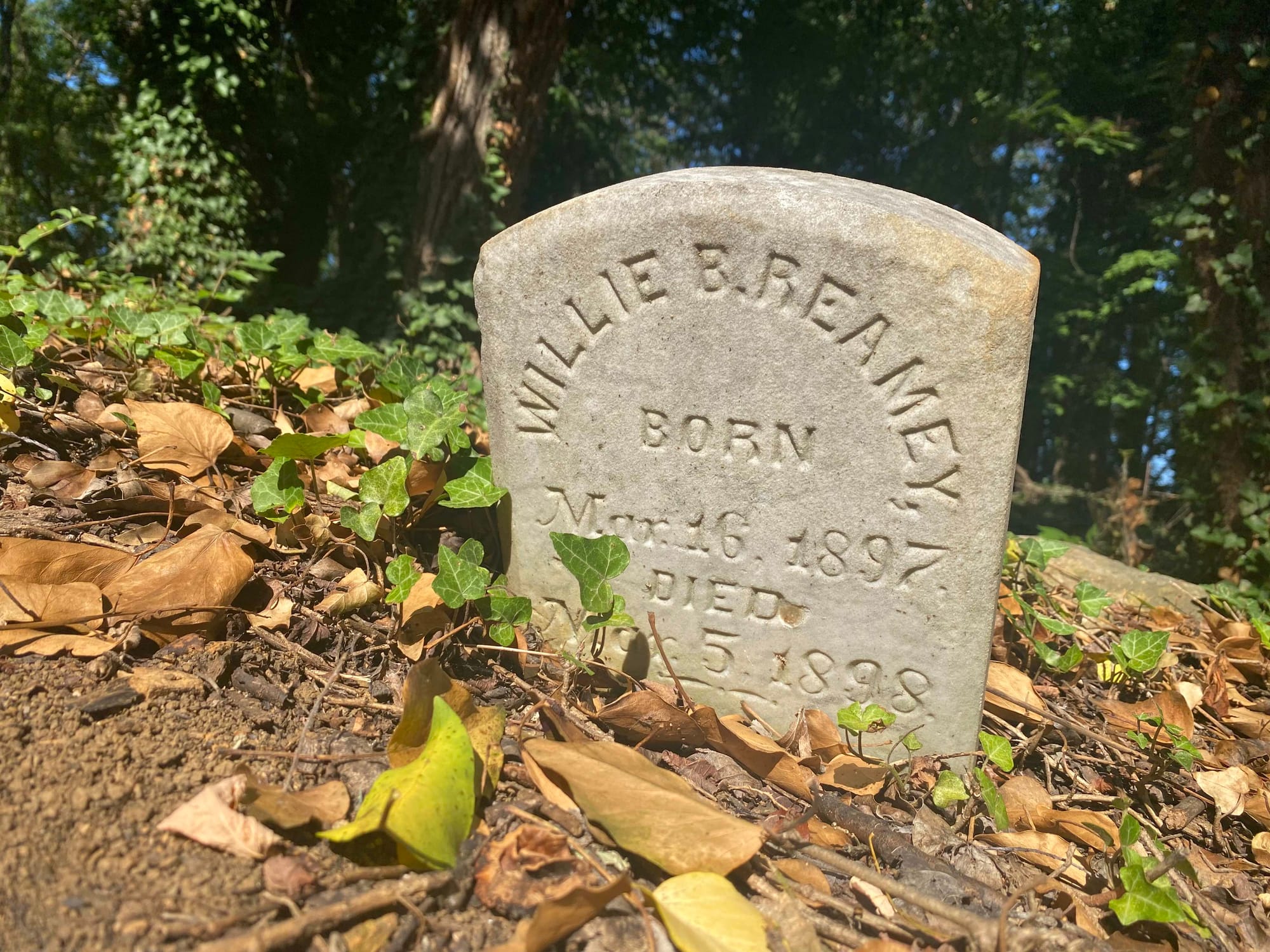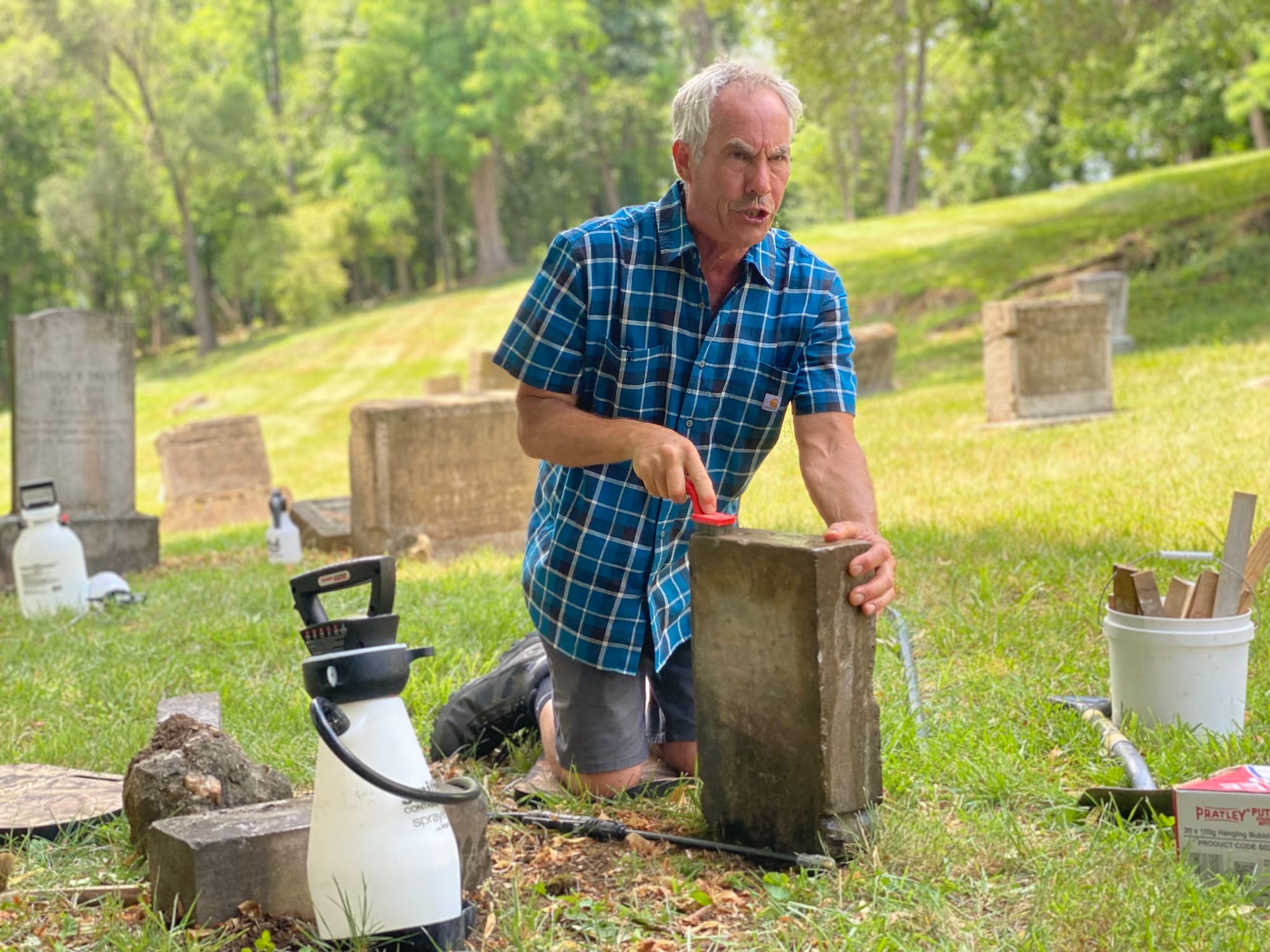At Roanoke's Historically Black Old Lick Cemetery, New Caretakers Confront Old Sins
In recent years, a group of churchgoers has been tending to the cemetery, a "gaping wound" of Roanoke's urban renewal history.

On a hot Saturday morning, across parched grassland, Madame Curie sniffs for graves.
Curie, a six-year-old Australian shepherd, scours a sloping hillside in Old Lick Cemetery, a historically Black burial ground, as Orange Avenue traffic zips by.
Nose to the ground, she meanders among the yucca and periwinkle, stops, sits down, and looks up, tongue lolling, at her handler, Carol Gilbert, who places a bright pink flag on the spot. Curie is certified to identify centuries-old human remains. This morning, she sits down 17 times, including at several spots that do not bear tombstones.
Old Lick Cemetery is where, in 1961, the city dug up 933 bodies and relocated them to a mass grave in Botetourt County, in order to build Interstate 581.
That act is seen by many residents as one of the most egregious from the era of urban renewal. Between the 1950s and 1980s, the city seized Black family’s land and razed 1,600 homes, 200 businesses and two dozen churches in Gainsboro and Northeast Roanoke as part of a nationwide trend in city redevelopment.
Curie’s search is not a one-off. It’s the latest initiative in an effort from a group of mostly retired white churchgoers that has been tending to the cemetery, clearing brush, mending tombstones and turning the land into a more formal site of healing and remembrance.
Ellen Forbes Stick, president of Friends of Old Lick Cemetery, said the work began as a community service project for students in 2019, when she oversaw social studies for Roanoke City Public Schools. Now employed at Roanoke Public Libraries, Stick has carried on the monthly work days with support from First Baptist Church of Gainsboro, which owns the cemetery.
“I felt like I was called to do it,” Stick said. “This is the gaping wound of the urban renewal story that Roanoke hasn’t fixed yet.”
Curie’s visit follows the use of ground-penetrating radar, which Stick said has already found 34 spaces indicating graves with no headstones.
“There could still be over a thousand people still here,” she said.

Heavy lifting
Future plans for the cemetery include a path leading to a meditation spot with benches and signage explaining the history of the cemetery; a black wrought-iron fence to replace a rusting chain link fence; and panels of local artists' work, including that of David Ramey Sr., an illustrator who died in 2017 and drew scenes of life before and during urban renewal.
The volunteers have created a new stone, engraved with the message, “In Memory of All Those Removed and Those That Remain.”
Last month, the group hosted a tombstone restoration expert, who picked Old Lick as one of two Virginia stops in his nationwide tour. Soon, a dozen goats will visit the cemetery to munch up brush.
Stick says she considers the group’s efforts as carrying on the mantle of Bob Hale, the late musician and photographer, who in the mid-2000s began cleaning up the cemetery. She credited First Baptist Church of Gainsboro with keeping the grassy section of the cemetery mowed.


Since 2019, a group of mostly retired white churchgoers that has been tending to the cemetery, clearing brush, mending tombstones and turning the land into a more formal site of healing and remembrance. PHOTOS BY HENRI GENDREAU FOR THE ROANOKE RAMBLER
Rev. Ronnie Parker, recently installed as pastor at First Baptist, said he was aware of the group’s efforts but not very familiar with them. A few congregants who left a recent Sunday service said they didn’t know about the clean-up efforts and had no personal connection to the cemetery, which last had interments in 1960.
David Collins, a member and trustee of First Baptist, said the congregation, which skews older, doesn’t have a lot of members who are able or willing to do major cemetery upkeep.
“The group has really done all that heavy lifting and gone back and cleaned up a lot of trash and debris that have been thrown on the property, so the church is really, really appreciative of it,” Collins said.
Collins grew up in Roanoke, where his father pastored First Baptist from 1968 until his death in 1970. Collins, a senior assistant city attorney, has helped Friends of Old Lick Cemetery toward becoming a formal association, meaning it can be an arm of the church and can apply for grants. Currently, the nonprofit Points of Diversity handles the group’s modest bank account.

The cemetery dates back to the mid-19th century, before Old Lick became Roanoke. Originally owned by St. John’s Episcopal Church and other white churches, the cemetery came under new ownership in 1895, when First Colored Baptist Church (later First Baptist) purchased the land.
As Roanoke prepared to use federal funds to create I-581, the city took control of the western end of the cemetery. In October 1961, the city began to dig up 933 graves, only 28 of which had legible grave markers, according to the Gainsboro History Project.
At the time, city officials sought out relatives of those buried, according to a 1961 article in The Roanoke Times.
“If no one steps forward, the officials say, the identities of all but a few people in the cemetery forever will be lost,” the newspaper wrote.
In the end, the city put the dead in a mass grave at Coyner Springs Cemetery, where a stone headed “Grant Them Eternal Rest” acknowledges the 933 bodies moved “in compliance with Ordinance No. 14568.”

A sacred place
In recent years, Old Lick has received renewed attention from community leaders.
The cemetery is one of six sites featured in Hidden in Plain Site Roanoke, a digital project that launched last year and highlights important areas of Black history. Councilwoman Trish White-Boyd spearheaded that project as part of a larger fundraiser to erect a statue of Henrietta Lacks downtown.
Vice Mayor Joe Cobb, a part-time pastor at Hermitage, a retirement home, recently completed a doctoral dissertation on the cemetery and the city’s role in desecrating it.
Stick was inspired by a presentation Cobb gave that included the idea for a labyrinth-like walkway. She wants to incorporate a similar meditative walking path through the cemetery’s more overgrown sections.
“Labyrinths are designed as pathways for centering, or moving more deeply into awareness of who we are as a people, who our ancestors are, and deepening that connection with our ancestors,” Cobb said. “This cemetery just seemed kind of a natural place, a sacred place for that to happen.”
Cobb and Stick said another potential addition is a better parking area near city-owned property at Carver Avenue, which would promote the cemetery as a place to visit.
On a recent Saturday, Fritz Oehlschlaeger, 74, was doing “grunt work,” removing logs and clearing brush from the land.
He learned about Friends of Old Lick Cemetery in a church bulletin from St. Andrew’s Catholic Church. He’s been coming to the monthly gatherings since last fall.
“I’m ashamed to say I drove past this place for 30 some-odd years … and I didn’t even know it was here,” Oehlschlaeger said. “I'd like to see Roanoke as a community, the city government …sort of embrace this and see it as a project of remembrance that’s well worth doing.”

